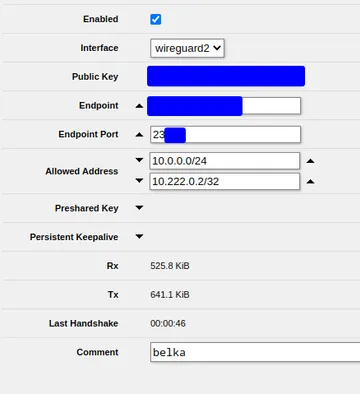Site 2 Site Wireguard VPN with a Mikrotik Router and a Cloud VM
My network consists of a server located in country A. Since the largest ISP in the country B does have terrible peering with the ISP in country A, I thought of setting up a small proxy server in country A. This way, I should be able to bypass bad peering, since the cloud provider probably organizes good routing to both sides. Since I meant to try out Oracles free tier anyway, it seemed like a good opportunity to learn ansible properly and develop with IaC scripts to set up a reverse proxy in the cloud.

- Create Wireguard keys. If the CLI is not an option this website is cool too (keys are client-sided generated)
- Since I want to have dedicated monitoring for what traffic is flowing between the proxy and my server, I create a new Wireguard interface in my Mikrotik router. Remember to use the previously generated keypairs.
- Create a new peer as follows. Important is the entry to allow the IP address of the
cloud wg endpoint, otherwise the cloud cant ping back home.

- I had to adjust the firewall rules to allow communication with the tunnel network.
- On the proxy server we use similar settings. Interestingly enough, the Mikrotik wg endpoint grabs the network address of the 10.222.0.0/30 network. Meaning, 10.222.0.1 is unallocated.
[Interface]
PrivateKey = REDACTED
Address = 10.222.0.2/30
ListenPort = 23xxx
[Peer]
PublicKey = REDACTED
AllowedIPs = 10.10.0.0/16,10.222.0.0/32
Endpoint = alphard.abc.de:23xxx- Next, we need to create a DDNS updater to keep our A record in sync with the publicly assigned IP address of the cloud provider (unless you wanna pay for a static address of course). I found this Docker container to be convenient.
- Finally, we need to update the IP address of the peer in the Mikrotik router. For that we use a Mikrotik script, which I stole from Uli Koehler . Remember to add a scheduler to the script.
:if ([interface wireguard peers get number=[find comment=belka] value-name=endpoint-address] != [resolve belka.abc.de]) do={
interface wireguard peers set number=[find comment=belka] endpoint-address=[/resolve belka.abc.de]
}Edit 22-10-2022:
After running this setup for a while, I found it a bit unstable. Since I do not get a static IP address from my ISP, my address changes every now and then. The wireguard client at the other hand does not recheck the A record but instead loses connection and requires a manual restart. I would recommend to use a more stable protocol like IPsec.